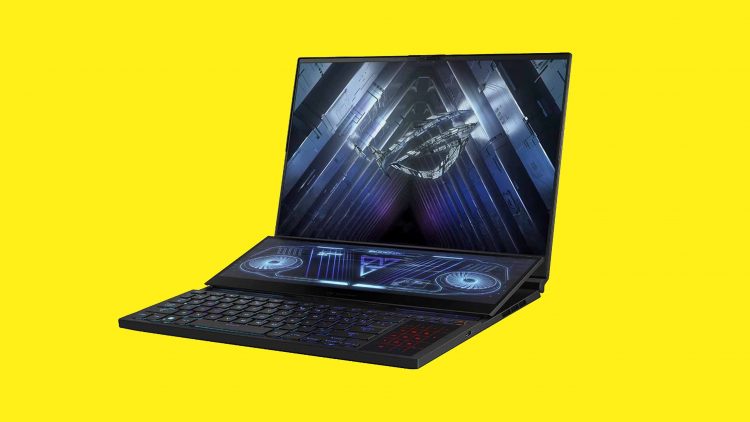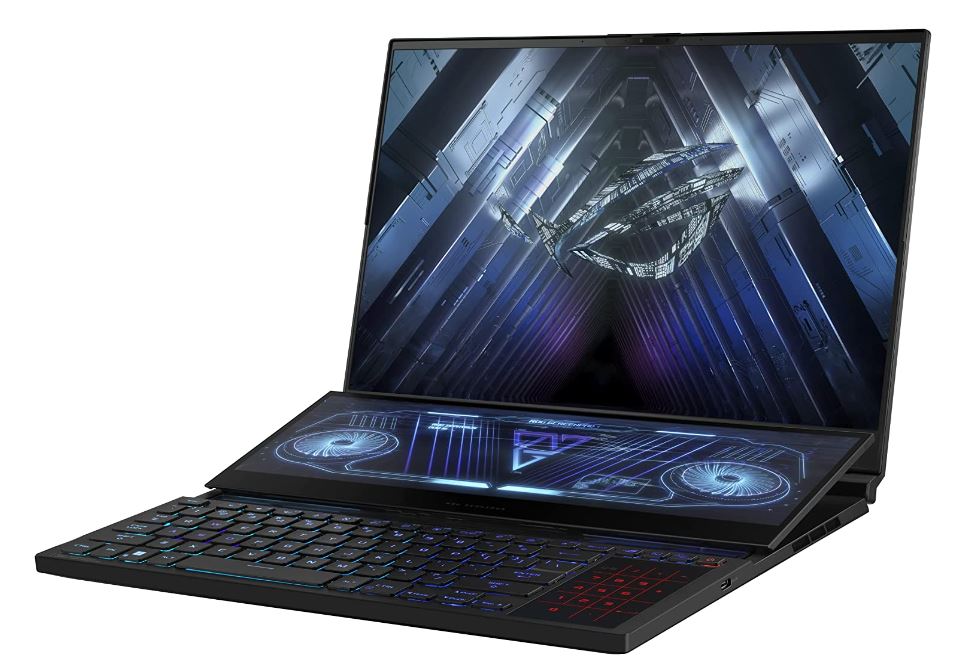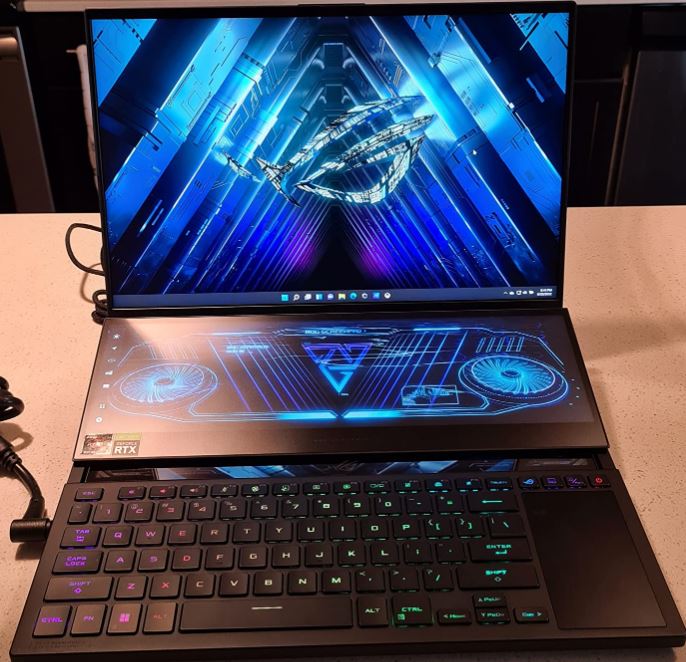In this post, we will review the Asus ROG Zephyrus DUO 16 GX650RM 144Hz, sharing observations and results acquired while using this laptop over the last two weeks.
My review device comes with an AMD Ryzen 7 6800H processor and RTX 3060 graphics, with the UHD+ dual-spec primary display option.
The Duo 16 is a unique performance gaming laptop, that provides two high-quality displays and incredibly powerful hardware characteristics in a premium design.
I think it is vital to recognise that the dual-screen design is the key reason to select the Zephyrus DUO 16 above the other alternatives out there with similar capabilities.
We will cover these down below, among all the other important aspects that you should know before stepping on one of these.
The laptop is also available with a QHD miniLED option for the primary screen, as well as in RTX 3070Ti, and RTX 3080 dGPU combinations.
ASUS ROG 16″ WUXGA 144Hz Gaming Laptop Review
Specification
| Brand | ASUS |
| Series | ASUS ROG Zephyrus Duo 16 |
| Item model number | GX650RM-ES94 |
| Standing screen display size | 16 Inches |
| Max Screen Resolution | 1920 x 1200 Pixels |
| Processor | 5 GHz ryzen_9 |
| RAM | 16GB |
| Memory Speed | 4800 MHz |
| Hard Drive | 1 SSD |
| Graphics Coprocessor | NVIDIA GeForce RTX 3060 |
| Wireless Type | Bluetooth |
| Number of USB 3.0 Ports | 2 |
| Operating System | Windows 11 Home |
| Item Weight | 5.51 pounds |
| Item Dimensions LxWxH | 13.98 x 10.47 x 0.81 inches |
| Color | Black |
Design
The ROG Zephyrus DUO 16 is a mid-sized laptop with two displays: a 16-inch 16:10 primary screen and a half-size secondary screen positioned on the upper part of the chassis termed a ScreenPad Plus.
This moves the keyboard and the click pad down to the front of the laptop.
The two displays given are the major selling factor of the series, plus the good underlying specs. The overall ergonomics are limited by this approach, though.
Having the keyboard positioned at the front of the laptop means that you’ll very much have to use this on a spacious desk, and less so on the move, or on the lap.
It also makes the click pad narrow and different from what other laptops offer.
Furthermore, with the dual displays, this laptop is heavier than other options with similar specs, and the battery life is impacted.
So overall, I consider the Zephyrus DUO primarily a desktop replacement series and not a performance ultraportable, like the other members of the Asus ROG Zephyrus family.
Previously, it only slanted up at a limited degree, but now it swivels to the back and tilts towards you at the same time.
This results in this secondary screen ending up more steeply inclined towards the user and providing a better viewing angle.
Alongside the installation of a 16:10 primary display with this iteration, this mechanism also minimizes the gap between the two screens.
At the same time, there is additional space now between the secondary screen and the laptop’s chassis.
Therefore, you will need to be extra careful not to get any debris, cables, or things caught in between the two components.
This is still a premium all-metal laptop with still a black design and limited branding components, with a somewhat cleaner lid now.
There are no obtrusive RGB features here, except for a discreet glass panel behind the ScreenPad, which is lit up by the keyboard’s LEDs and lets to look into the internals in a tasteful way.
Also, the sticky rubber feet provide excellent stability on the tabletop, and the hinge mechanism properly holds the two screens in place.
This helps to expand the main screen with a single hand without lifting up the base. That’s supported by the fact that the Duo 16 has a fairly substantial build, at 2.5 kilos / 5.51 lbs. In comparison, the Zephyrus M16 is 1 pound lighter.
The thermal design is also a unique selling point for the Duo, and it’s termed AAS Plus 2.0.
Display
The enlarged primary screen is likewise more advanced than earlier.
First of all, Asus provides two panels for the display, one with the QHD and the other one with a dynamic resolution dual spec version.
Since the display is in a 16:10 aspect ratio, the actual resolutions are not the normal 16:9 values you may be used to, but the equivalent.
That means the QHD panel in our testing model carries a 2,560-by-1,600-pixel native resolution, along with a 165Hz refresh rate.
The dual spec panel, meanwhile, is something else. While the resolution and refresh rate of our QHD-screen unit is static, this screen allows for variable combinations at 4K and full HD.
This means it can adjust the refresh rates alongside the resolutions to suit different use cases.
With this panel, you may run full HD at 240Hz, or 4K at 120Hz depending on your demands at the moment.
Combining 4K resolution and a 240Hz refresh rate would put a lot of extra work on the GPU, and almost no games are played this way.
Therefore, Asus has connected the higher refresh rate to the lesser resolution.
Our unit doesn’t feature this kind of panel, though, so we can only conjecture.
Automatic adaption seems useful when you need to move down to 120Hz and 4K.
You could imitate the effect on any laptop by manually restricting the frame rate and altering resolution in-game settings.
As for the ScreenPad Plus, it’s a small LED touch panel with an extraordinarily high contrast ratio.
The Duo 16’s ScreenPad measures 14 inches diagonally, clearly an uncommon size considering the panel’s odd elongated form.
The standard resolution of the ScreenPad Plus on our model is a “4K equivalent” (3,840 by 1,110 pixels) with a 60Hz refresh rate, but you may choose to get a full HD 60Hz variation instead.
The size of this panel is truly practical and roomier than similar designs.
It is incredibly bright, huge enough to move past being just a curiosity, and practical thanks to the software options.
Hardware and Performance
Our test model is a configuration of the ASUS ROG Zephyrus Duo 16, code name GX650RM, constructed on an AMD Ryzen 7 6800H processor.
Also comes with 16 GB of DDR5-4800 memory in dual channels, 1 TB of middling SSD storage, and dual graphics: the Nvidia RTX 3060.
Given that our review model includes an RTX 3060, we weren’t that startled when the Asus ROG Zephyrus Duo 16 fared admirably in our suite of gaming benchmarks.
With its Ryzen 7 6800H and 16GB of RAM, the Asus ROG Zephyrus Duo 16 is outrageously, thunderously fast, both in benchmarks and in real-world use.
You are not going to have any difficulty working in mainstream content production software, or even most professional products. This is a highly capable machine.
Note that while we have used the 1440p QHD presets for our results, this display is actually 2560×1600 pixels due to the 16:10 aspect ratio.
Which has little influence on overall performance. Still, it shouldn’t require much tuning to get this laptop playing the latest games at 60+ fps per second at the native QHD+ resolution.
General performance in synthetic benchmarks was impressive too, with the Ryzen 7 6800H smashing through our CPU tests with its massive 4.7GHz boost clock.
If you are considering utilizing this laptop for both works and play, it can comfortably manage it.
Keyboard and Trackpad
The keyboard on ROG Zephyrus DUO is an almost identical layout that Asus provides with the ROG Strix G15 and Scar 15 models.
It’s a rubber dome implementation with superb feedback, silent actuation, lovely feeling keycaps, and per-key RGB control.
There’s little to dislike about this keyboard as a whole. What makes this remarkable is the positioning on the front of the laptop, which makes typing on this keyboard equivalent to typing on a PC keyboard.
Asus even included a rubber armrest, which I found useful, even if it doesn’t attach magnetically to the laptop and dirts up quickly.
Asus offer far superior armrests with their PC keyboards, and they could have included something better with this premium laptop as well.
Anyway, I actually enjoyed typing on this keyboard much more than on the Scar/Strix laptops, but you have to position the laptop on an expansive desk that offers proper arm support.
As for the click pad, well that’s narrow and located on the right side of the keyboard.
Compared to the previous generation, the surface is larger now as Asus discarded the physical click buttons for a glass clickable implementation that occupies the entire available space.
It takes some time to get used to this clickpad being positioned where it is, but it kind of grows on you once you use it.
Connectivity
As far as the IO goes, Asus spread it along the sides and the back.
Many ports are still set on the front side of the left edge, crowding that region when attaching peripherals to the USB-C and A ports, and the power plug is also placed here, which is much more annoying.
I hope Asus would have been able to send this to the back, close to the HDMI and LAN connections.
As far as the USB-C ports go, the one on the left edge enables charging and DP (dGPU connection).
While the one on the right is data and video only, with an iGPU connection.
I will also remark that a full-size card reader would have made a lot of sense with this design, but unfortunately, there’s only a tiny SD card reader supplied.
Audio
One thing that absolutely blew me away was the high-end sound quality.
Six speakers and two woofers with surround sound provide a stunning soundstage that shines in action-packed games arguably the best I have ever seen in a gaming laptop.
Battery life
There’s a 90Wh battery inside this ROG Zephyrus Duo 16.
The system automatically adjusts the screen’s refresh to 60 Hz when running the laptop on battery.
To optimize efficiency, and that’s the fast screen flicker that you’ll see after unplugging the laptop from the wall.
Also, if you want to maximize runtimes, make sure to operate the laptop in the Hybrid MUX mode.
You should bear in mind that there are two screens on this laptop, and you should switch off the ScreenPad to get the best potential runtimes.
Here is what we got on our review device in terms of battery life,
The laptop is on Hybrid mode with only the primary display active and its brightness set at roughly 120 nits.
It will give you around 4 to 6 hours of battery life while writing documents in Google drive with WiFi on.
The Asus ROG Zephyrus Duo 16 ran out of battery in just six hours and two minutes.
Which reflected our hands-on experience watching streaming video, browsing the Web and using basic browser-based apps.
More demanding applications are going to use the battery more, and playing games, you will be lucky to achieve an hour of use unless you reduce the brightness right down.
Pros:
- Top gaming performance
- Beautiful OLED screen
- Delightful secondary screen
- High power processor
Cons:
- Small trackpad
- Unimpressive battery life
- Not travel-friendly charger
Conclusion
The Asus ROG Zephyrus Duo 16 is going to be a wonderful pick for gaming at 1080p and 1440p.
The screen is bright and vivid, the keyboard is snappy, and the RTX GPUs on offer here are all fantastic for gaming.
The ScreenPad Plus is a nifty feature that some customers will get more mileage out of.
If you are searching for a high-powered laptop for gaming, work, and content creation, this could be the one for you.
Look, the speakers on this laptop genuinely blew me away.
Gaming laptops typically have issues with built-in audio that is underwhelming or merely okay, but the speaker array on this bad boy is robust and the surround sound works beautifully.



